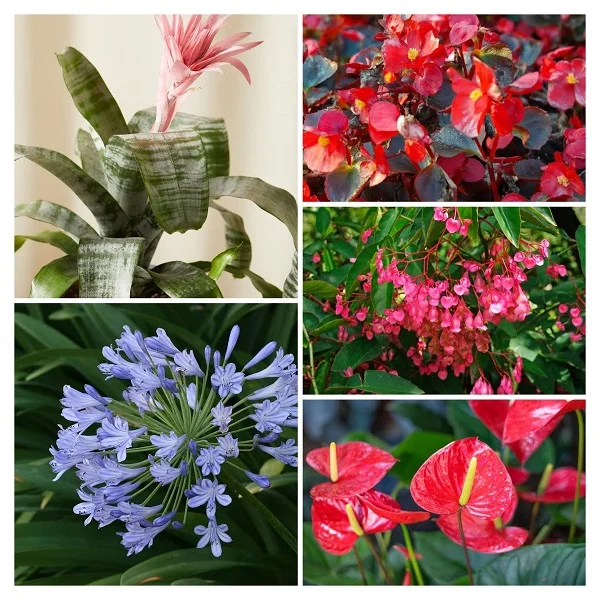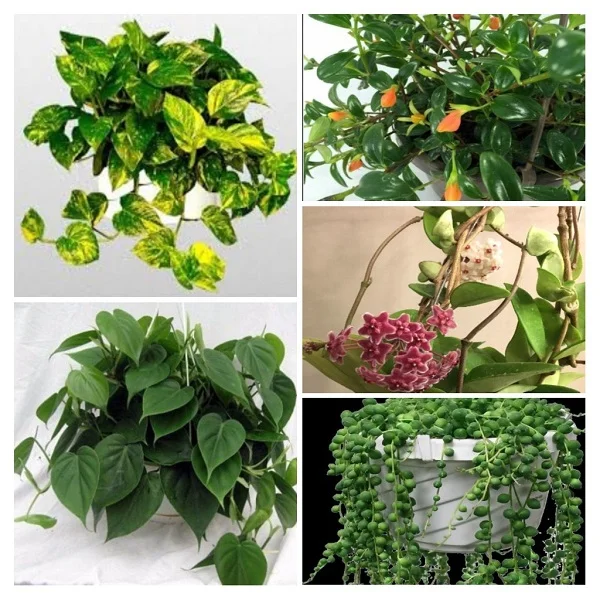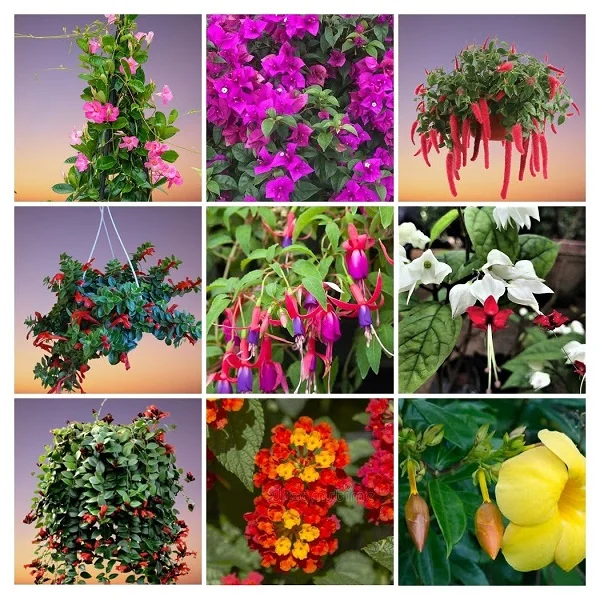Lipstick Plant Care Indoors, Propagation & Problems (Aeschynanthus radicans)
Some links in this post may be affiliate links
Lipstick Plant (Aeschynanthus radicans) thrives in very bright indirect light, warm and humid conditions and consistently moist, rich, well-drained soil coupled with monthly feeding in the growing season.
Aeschynanthus radicans also called Lipstick Vine or Basket Vine is an evergreen, vining, perennial plant which bears leathery, ovate to lanceolate, green leaves and vibrant red tubular flowers with yellow throats.
Lipstick Plant is ideal for a hanging basket or a trellis where the beautiful leaves and vibrant flowers can be displayed for a spectacular sight.
The Lipstick Vine is a tropical plant which requires warm and humid conditions to thrive. It is not cold hardy, therefore, it is best grown as a houseplant in the temperate regions.
However, the Lipstick Plant can be grown outdoors as a container plant in areas with harsh winters which is brought inside in winter and treated as a houseplant when the temperatures drop to about 120C.
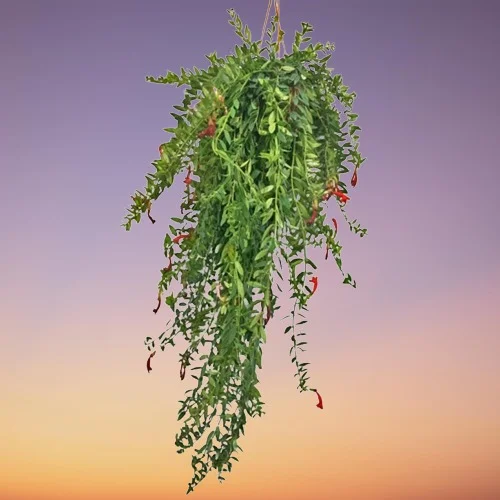
Botanical name: Aeschynanthus radicans
Family: Gesneriaceae
Common names: Lipstick Plant, Lipstick Vine, Basket Vine
Origin
Aeschynanthus radicans is native to the tropical regions of Malay Peninsula south to Java where it is found growing as an epiphyte (on trees) or lithophyte (in or on rocks).
Size
Lipstick Vine is a vining plant whose stems can grow from 3-5 feet long which makes it one of the best flowering plants for hanging baskets.
Flowers
Lipstick Plant bears terminal, tubular, scarlet flowers with yellow throats, about 5–7.5 cm long, whose upper lobes are shorter than the lower ones in spring and summer. The common name, 'Lipstick Plant', comes from the scarlet flowers which open from buds that resemble tubes of lipstick.
Are Lipstick Plants toxic?
Aeschynanthus radicans is considered non-toxic to pets as indicated by ASPCA. Lipstick Plants are non-toxic to cats, dogs and other pets. They are safe to grow in the home.
Types of Lipstick Plants
How many types of Lipstick Plants are there?
There are over 185 species of Lipstick Plants belonging to the family Gesneriaceae. Some of the popular varieties include;
Variegated Lipstick Plant whose leaves bear striking white streaks.
Curly Lipstick Plant with curly, dark-green leaves and vibrant scarlet red flowers.
Variegated Curly Lipstick Plant which bears curly, yellowish-green leaves and orange-red blooms.
Mona Lisa Lipstick Plant with waxy, dark green leaves and vibrant red and orange flowers.
Twister Lipstick Plant with pointed, twirling dark-green leaves and red blooms.
Black Pagoda Lipstick Plant also called Hoya Lipstick Plant due to its resemblance to Hoya Plants bears shiny, dark-green leaves with purple variegations on the upper- and under-sides and greenish yellow flowers.
Where to Buy
If you are looking to add Lipstick Plant to your collection, you may acquire them online from Etsy (Link to Etsy).
How to care for Aeschynanthus radicans indoors
To care for Lipstick Plant (Aeschynanthus radicans) indoors, give it very bright indirect light, warmth of 18-280C, humidity of 60-70% and consistently moist, rich, well-drained soil coupled with monthly feeding during the growing season.
Lipstick Vine requires regular trimming of the stems to keep it full and beautiful. Repotting is only needed when the plant becomes potbound. Keep reading for more details on these growing conditions and how to achieve them.
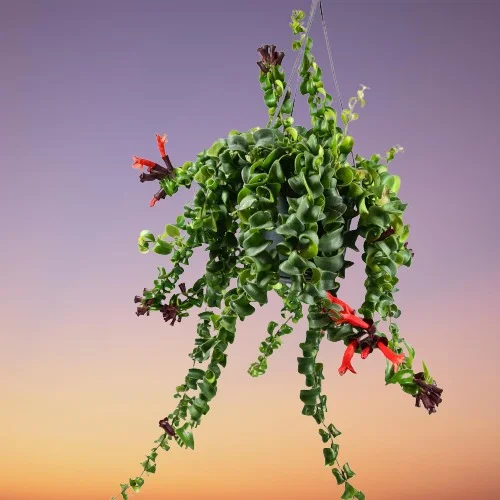
Watering
How often should I water my Lipstick Plant?
Water your Lipstick Plant liberally in spring and summer when the top 1-2 inches of soil feel dry to the touch. Keep the soil consistently moist and avoid overwatering to prevent rotting, yellowing, leaf loss and lack of blooms.
Cut down on watering in fall and winter as growth is minimal at this time to maintain the soil slightly moist. Do not allow the soil to dry out completely to avoid wilting, leaf fall and lack of flowers.
Use water that is free of chlorine and other dissolved chemicals to prevent browning of leaf edges and tips. Ensure that the water is at room temperature to prevent cold shock which can result in stunted growth, leaf drop and no flowers.
Confirm that the pot has a drainage hole and the soil is well-draining to prevent waterlogging as it can lead to root-rot and eventual loss of the plant.
Light Requirements
Do Lipstick Plants like sun or shade?
Lipstick Plant grows best in very bright indirect light to promote flowering. A spot infront of a brightly-lit window is ideal for this plant. Keep it away from direct sunlight as it can scorch the leaves.
Regularly turn the pot to ensure the Basket Vine receives adequate light on all sides to promote even growth and prevent the plant from getting leggy.
If the light is too low it may result in yellowing, leggy growth and lack of blooms. Therefore, you may use grow lights where the natural light is not sufficient.
Temperature and Humidity
Lipstick Vine prefers an average warmth of 18-280C. Keep it away from drafts comming from windy doors, drafty windows, AC units, hot air vents and others which may lead to stunted growth, leaf drop and lack of blooms.
Lipstick Plant does best in humidity between 60-70%. Too low humidity may result in brown leaf tips and edges and lack of flowering. To heighten humidity for the plant, set the pot on a wet pebble tray, group the plants together or use a cool mist humidifier. Maintain good air circulation to discourage fungal diseases.
Fertilizer
What is the best fertilizer for Lipstick Plant?
Feed Lipstick Vine every 3-4 weeks in spring and summer with a water-soluble fertilizer containing micronutrients to boost blooming and healthy growth of the plant.
Do not feed in fall and winter as growth is reduced at this time and feeding the plant at this time may result in fertilizer burn and death of the plant.
Potting Mix
What is the best soil for Lipstick Plant?
The best soil for Lipstick Plant should be rich in organic matter to provide the required nutrients and at neutral to alkaline PH for optimum growth of the plant. A well-drained soil is recommended to avoid getting soggy soil which can lead to root-rot and death of the plant.
Repotting
When to repot a Lipstick Plant
Repot Lipstick Plant at the beginning of spring to early summer, only when it becomes extremely pot-bound as it blooms more when slightly pot-bound. Do not repot a plant that is in flower as it can shorten the flowering period.
How to repot a Lipstick Plant
- Select a pot 1 size larger than the current one that has a drainage hole to prevent rotting and eventual death of the plant. Check out these pots with drainage holes on Amazon.
- Carefully, slip the plant out of its pot, shake off the old potting mix and trim the dead roots with clean and sterilized scissors.
- Place the plant in the center of the new pot and refill with fresh free-draining potting mix.
- Thoroughly wet the soil until water comes out through the drainage hole, empty the saucer.
- Replace the plant infront of a brightly-lit window away from direct sunlight and carry on with routine care.
Pruning & Grooming
Pruning Lipstick Plant involves removal of dead leaves and flowers to keep the plant neat and also discourage pests and diseases.
To encourage blooming trim the stems to about 6-8 inches after flowering for better light penetration.
Regularly clean the leaves with a soft brush to get rid of dust as well as discourage pest infestations.
Aeschynanthus radicans Propagation
Aeschynanthus radicans or Lipstick Plant is propagated from soft stem cuttings at the beginning of the growing season (spring to early summer)) when in active growth.
Propagating Lipstick Plant from soft stem cuttings
- With a clean, sharp scissors or knife, take a 4-5 inches soft stem cuttings from a healthy branch.
- Strip off the lower leaves and dip the lower cut end in rooting powder to hasten rooting.
- Fill a small pot with well-draining rooting soil and moisten it slightly. Use a pot that has a drainage hole to prevent rotting.
- Insert the lower cut end in the moist rooting mix while taking care not to brush off the rooting powder.
- Cover the set up with a plastic sheet to create a greenhouse effect.
- Place the set up in a warm, brightly-lit spot away from direct sunlight to avoid scorching the cuttings.
- Maintain the soil moist through out until the new plants are well established.
- Allow the new plants to be well established before transplanting after which you can begin routine care.
How to grow Lipstick Plant from seeds
- Fill a seed tray with well-draining rooting soil and lightly moisten it.
- Spread the seeds evenly on moist soil and cover lightly with some soil.
- Cover the set up with a plastic sheet to create a greenhouse effect to encourage germination.
- Place the set up in a warm, well-lit place away from direct sunlight to prevent scorching.
- Maintain the soil moist through out by gently misting the soil surface until the seedlings are well established.
- Transplant the new plants when the seedlings are well established after which routine care can begin.
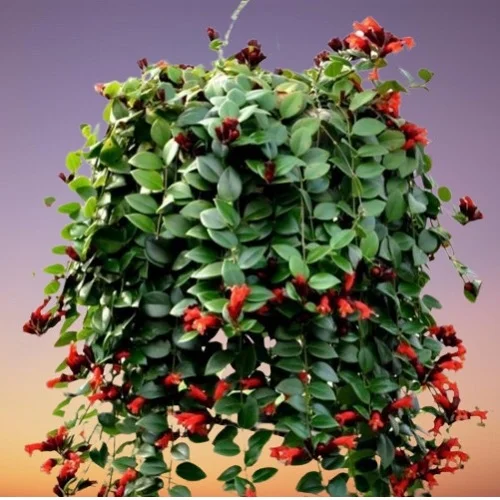
Aeschynanthus radicans Problems & Remedies
Aeschynanthus radicans (Lipstick Plant) problems are lack of blooms, plant dying, brown leaf tips and shrivelled leaf edges, leaf drop, leggy growth, pests among others. Keep reading for more on these problems and how to fix them.
Lack of blooms
Why does my Lipstick Plant not flower?
Your Lipstick Plant is not flowering due to inconsistent watering, nutrients deficiency, too little light, lack of pruning, dry air, temperature stress frequent repotting or cold water.
How to fix it
Inconsistent watering: Water when the top 1-2 inches feel dry. Do not water on a schedule.
Lack of nutrients: Fertilize the plant with a water-soluble, fertilizer that is rich in Phosphorous and Potassium and contains micronutrients every 3-4 weeks in spring and summer.
Too little light Position the plant in a brightly-lit place where it will receive very bright indirect light or invest in a grow light if the natural light is not adequate.
Lack of pruning: Trim the stems to 6-8 inches after blooming to encourage growth of fresh growth and also encourage light penetration.
Dry air: Use a wet pebble tray, group the plants together or grow the plant in a well-lit bathroom and other humid areas.
Temperature stress: Keep the plant away from sources of drafts like AC units, hot air vents, windy doors and windows among others.
Too frequent repotting: Repot it only when extremely pot-bound as it blooms when slightly pot-bound.
Cold water: Water with water that is at room temperature to avoid cold shock.
Plant dying
Why is my Lipstick Plant dying?
Your Lipstick Plant may be dying due to too little light, incorrect watering, soggy soil, temperature stress, dry air or root-rot.
How to rescue a Lipstick Plant
Too little light: Move the plant to a brighter spot where it will receive very bright indirect light or instal a grow light if the natural light is not enough.
Incorrect watering: Do not water on a schedule. Water only when the top 1-2 inches of soil dry out.
Soggy soil: Use a pot with a drainage hole and a well-draining soil.
Temperature stress: Keep the plant away from sources of drafts like hot surfaces, hot air vents, AC units, windy doors among others.
Dry air: Set the pot on a wet pebble tray, use a cool mist humidifier, group the plants together or grow the plant in a well-lit bathroom and other humid areas.
Root-rot: This is a fungal disease that is prevalent in soggy soil due to poor soil drainage.
How to fix it
- Slip the plant out of its pot, wash off the soil and inspect the roots.
- Brown-black, mushy roots indicate root-rot; cut them away. In addition, cut away any stems showing any signs of rot.
- Disinfect the remaining roots and the entire plant with a copper-based fungicidal solution as recommended by the manufacturer.
- Disinfect the pot with the fungicidal solution or use a fresh pot to repot the plant in fresh potting soil.
- Ensure that the pot has a drainage hole and the soil is well-draining to prevent waterlogging.
- Water the plant with the fungicidal solution and place it in a warm, brightly-lit spot.
- Do not water the plant again until new growth appears and avoid overwatering and soggy soil thereafter.
Brown leaf tips and shrivelled leaf edges
Brown leaf tips and shrivelled leaf edges on Lipstick Plant are due to dry air, underwatering, use of hard water or temperature stress.
How to fix it
Dry air: Set the pot on a wet pebble tray, group the plants together or grow the plant in a a brightly-lit bathroom, kitchen, laundry area and other humid areas in the home.
Underwatering: Do not water on a schedule. Water when the top 1-2 inches dry out. Never allow the soil to dry out completely.
Use of hard water: Use chlorine-free water like rain water or filtered water.
Temperature stress: Keep the plant away from drafts emanting from AC units, windy doors, hot surfaces, hot air vents among others.
Leaf drop
Leaf drop on Lipstick Plant is caused by inconsistent watering, soggy soil, drafts, too cold water or low humidity.
How to fix it
Inconsistent watering: Water when the top 1-2 inches dry out. Do not water on a schedule.
Soggy soil: Use a pot with a drainage hole and well-draining soil.
Drafts: Keep the plant away from sources of drafts to maintain a warmth of 18-280C.
Too cold water: Use water that is at room temperature.
Low humidity: Group the plants together, use a humidifier or set the pot on a wet pebble tray.
Leggy growth
Leggy growth on Lipstick Plant is caused by too little light, nutrients deficiency or underwatering.
How t fix it
Too little light: Position the plant in very bright indirect light or instal a grow light if the natural lighting is not adequate.
Nutrients deficiency: Feed the plant with a liquid, fertilizer that is rich in Phosphorous and Potassium and contains micronutrients every 3-4 weeks in spring and summer.
Underwatering: Maintain the soil moist in spring and summer and slightly moist in fall and winter. Never allow the soil to dry out completely.
Pests
Common pests on Lipstick Plant are aphids, mealybugs and spidermites which are promoted by extremely dry air.
How to fix it
- Isolate the affected plant to prevent spread to other plants.
- Treat the affected plant with neem oil or insecticidal soap as indicated by the manufacturers'.
- Maintain the plant well pruned to discourage the pests.
- Increase humidity to minimize the pests infestations.
Frequently Asked Questions
1. How to make Lipstick Plant bloom indoors?
Lipstick Plant is a prolific bloomer. To make it bloom indoors:
- Give it bright indirect light or use a grow light in you do not have enough light in your home.
- Water it when the top 1-2 inches of soil dry out. Avoid overwatering or underwatering.
- Maintain an average warmth of18-280C and a humidity of 60-70%.
- Fertilize it every 2-3 weeks in spring and summer with a water-soluble, fertilizer that is rich in Phosphorous and Potassium and contains micronutrients.
- Keep it well pruned: trim the stems to 6-8 inches after blooming to encourage growth of fresh growth and also encourage light penetration.
- Avoid too frequent repotting as it blooms more when slightly pot-bound.
- Regularly inspect the plant for pests and diseases and carry out timely control measures.
2. How often does Lipstick Plant bloom?
When given the right growing conditions, Lipstick Plant will bloom the year round with most blooming occuring in spring and summer.
3. Is Lipstick Plant poisonous?
No. As indicated by ASPCA, Lipstick Plant is non-toxic to both humans and pets. It is safe to grow in the home.
4. Can you take cuttings from a Lipstick Plant?
Yes. Lipstick Plant is easily propagated at the beginning of the growing season from stem cuttings which can be rooted either in water or in soil.
5. Do Lipstick Plants have to hang?
Yes. Lipstick Plants are vining plants which look spectacular in a hanging basket, on a shelf, on a table or any other place where the stems can cascade downwards.
You liked it? Share on social media.
Recommended
Amazon Associates Disclosure
Homeplantsguide.com is a participant in the Amazon Services LLC Associates Program, an affiliate advertising program designed to provide a means for sites to earn advertising fees by advertising and linking to amazon.com.



